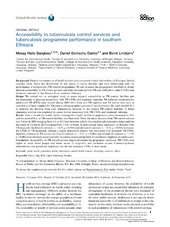| dc.contributor.author | Dangisso, Mesay Hailu | en_US |
| dc.contributor.author | Datiko, Daniel Gemechu | en_US |
| dc.contributor.author | Lindtjørn, Bernt | en_US |
| dc.date.accessioned | 2016-08-04T11:04:27Z | |
| dc.date.available | 2016-08-04T11:04:27Z | |
| dc.date.issued | 2015-11-20 | |
| dc.Published | Global health action 2015, 8:29443 | eng |
| dc.identifier.issn | 1654-9880 | |
| dc.identifier.uri | https://hdl.handle.net/1956/12438 | |
| dc.description.abstract | Background: Despite the expansion of health services and community-based interventions in Ethiopia, limited evidence exists about the distribution of and access to health facilities and their relationship with the performance of tuberculosis (TB) control programmes. We aim to assess the geographical distribution of and physical accessibility to TB control services and their relationship with TB case notification rates (CNRs) and treatment outcome in the Sidama Zone, southern Ethiopia. Design: We carried out an ecological study to assess physical accessibility to TB control facilities and the association of physical accessibility with TB CNRs and treatment outcome. We collected smear-positive pulmonary TB (PTB) cases treated during 2003–2012 from unit TB registers and TB service data such as availability of basic supplies for TB control and geographic locations of health services. We used ArcGIS 10.2 to measure the distance from each enumeration location to the nearest TB control facilities. A linear regression analysis was employed to assess factors associated with TB CNRs and treatment outcome. Results: Over a decade the health service coverage (the health facility–to-population ratio) increased by 36% and the accessibility to TB control facilities also improved. Thus, the mean distance from TB control services was 7.6 km in 2003 (ranging from 1.8 to 25.5 km) between kebeles (the smallest administrative units) and had decreased to 3.2 km in 2012 (ranging from 1.5 to 12.4 km). In multivariate linear regression, as distance from TB diagnostic facilities (b-estimate=−0.25, p<0.001) and altitude (b-estimate=−0.31, p<0.001) increased, the CNRs of TB decreased, whereas a higher population density was associated with increased TB CNRs. Similarly, distance to TB control facilities (b-estimate=−0.27, p<0.001) and altitude (b-estimate=−0.30, p<0.001) were inversely associated with treatment success (proportion of treatment completed or cured cases). Conclusions: Accessibility to TB control services improved despite the geographic variations. TB CNRs were higher in areas where people had better access to diagnostic and treatment centres. Community-based interventions also played an important role for the increased CNRs in most areas. | en_US |
| dc.language.iso | eng | eng |
| dc.publisher | Co-Action Publishing | eng |
| dc.relation.ispartof | <a href="http://hdl.handle.net/1956/12839" target="_blank">Tuberculosis control in Sidama in Ethiopia. Programme performance and spatial epidemiology</a> | |
| dc.rights | Attribution CC BY | eng |
| dc.rights.uri | http://creativecommons.org/licenses/by/4.0/ | eng |
| dc.subject | public health | eng |
| dc.subject | population health | eng |
| dc.subject | tuberculosis control | eng |
| dc.subject | health systems | eng |
| dc.subject | developing countries | eng |
| dc.subject | Africa | eng |
| dc.title | Accessibility to tuberculosis control services and tuberculosis programme performance in southern Ethiopia | en_US |
| dc.type | Peer reviewed | |
| dc.type | Journal article | |
| dc.date.updated | 2016-04-08T11:24:59Z | |
| dc.description.version | publishedVersion | en_US |
| dc.rights.holder | Copyright 2015 Mesay Hailu Dangisso et al. | |
| dc.identifier.doi | https://doi.org/10.3402/gha.v8.29443 | |
| dc.identifier.cristin | 1332848 | |

